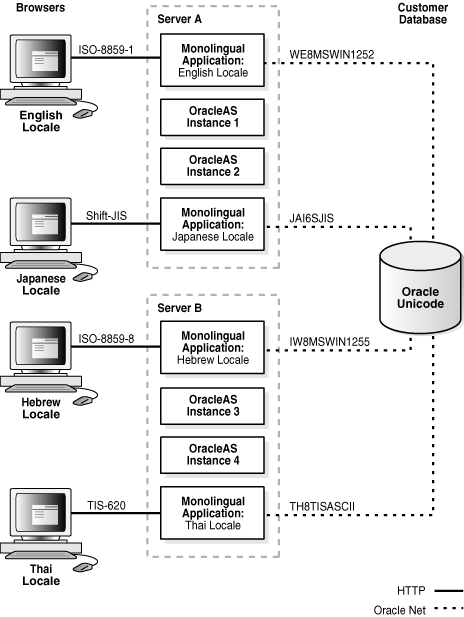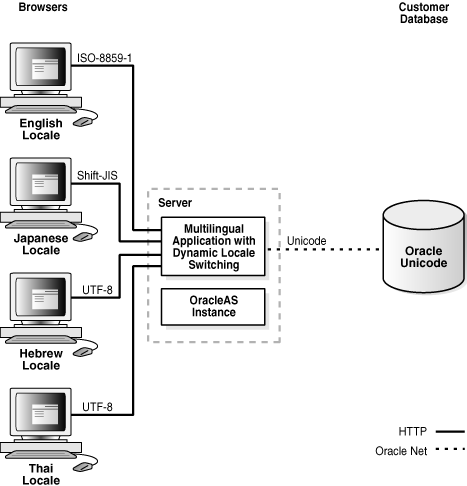|
Oracle® Application Server Globalization Support Guide
10g Release 2 (10.1.2) B14004-02 |
|
 Previous |
 Next |
|
Oracle® Application Server Globalization Support Guide
10g Release 2 (10.1.2) B14004-02 |
|
 Previous |
 Next |
This chapter contains the following topics:
It is important for businesses to make their Internet applications available to users around the world with appropriate locale characteristics, such as language and currency formats. Oracle Application Server is fully internationalized to provide a global platform for developing and deploying Internet applications.
Building an Internet application or Web site for Oracle Application Server requires good globalization practices in development and deployment. This book describes recommended globalization practices.
You need to be familiar with the following concepts to understand globalization:
Locale refers to a language, a character set, and the region (territory) in which the language is spoken. Information about the region includes formats for dates and currency. For example, the primary languages of the United States and Great Britain are both forms of English, but the two territories have different currencies and different conventions for date formats. Therefore, the United States and Great Britain are different locales.
A character set defines the binary values associated with the characters that make up a language. For example, the ISO-8859-1 character set can be used to encode most Western European languages.
There are several approaches to designing global Internet applications. This book discusses the following approaches:
Monolingual
You can design a monolingual Internet application so it supports several instances. Each instance supports a different locale. Users with different locale preferences must invoke the instance that serves their locale.
Multilingual
You can design a multilingual Internet application to support several locales with one instance. All users, regardless of locale, can invoke the same instance.
Both designs include one centralized database that uses a Unicode character set.
Figure 1-1 shows the design of a monolingual Internet application.
Figure 1-1 Monolingual Internet Application Architecture

The clients (in English, Japanese, Hebrew, and Thai locales) communicate with separate instances of Oracle Application Server through HTTP connections. One instance of the application runs in the same locale as one of the Oracle Application Server instances. For example, the English application runs in the same locale as Oracle Application Server Instance 1. The English and Japanese applications and their Oracle Application Server instances are running on Server A, and the Hebrew and Thai applications and their instances are running on Server B. Each Oracle Application Server instance communicates with the Unicode database. The instances communicate with the database through Oracle Net.
The client character set for the English locale, for example, is ISO-8859-1. The Oracle Application Server instance that is associated with the English locale, Instance 1, uses the Oracle character set WE8MSWIN1252 to communicate with the database. The database character set is a Unicode character set.
Table 1-1 shows the advantages and disadvantages of deploying monolingual Internet applications. As the number of locales increases, the disadvantages outweigh the advantages of the monolingual design. This type of application design is suitable for customers who support only one or two locales.
Table 1-1 Advantages and Disadvantages of Monolingual Internet Application Design
| Advantages | Disadvantages |
|---|---|
|
You can separate the support of different locales into different servers. This allows locales to be supported in different time zones. Work load can be distributed accordingly. |
There are more Oracle Application Server servers to administer. |
|
Writing the code is simpler than for a multilingual Internet application. |
The Internet application requires more testing resources to certify it on each Oracle Application Server instance. |
|
|
You must configure Oracle Application Server for each instance of the application. |
|
|
You must maintain a server instance for each locale regardless of the amount of work that is demanded of it. Load-balancing is possible only among a group of Oracle Application Server instances that support the same locale. |
|
|
Supporting multilingual content is difficult. |
Figure 1-2 shows the design of a multilingual Internet application.
Figure 1-2 Multilingual Internet Application Architecture

The clients (in English, Japanese, Hebrew, and Thai locales) communicate with one Oracle Application Server instance through HTTP connections. Each client can use a different character set because each application running on Oracle Application Server is configured to support several locales simultaneously, regardless of the locale of the Oracle Application Server instance. The Oracle Application Server instance and the database communicate through Oracle Net. Both the application running on the Oracle Application Server instance and the database use Unicode character sets.
In order to support several locales in a single application instance, an application should:
Process character data in Unicode so that it can support data in any language
Dynamically detect the user's locale and adapt to the locale by constructing HTML pages in the correct language and cultural conventions
Dynamically determine the character set to use for HTML pages and convert content to and from Unicode to the HTML page encoding
Table 1-2 shows the advantages and disadvantages of deploying multilingual Internet applications.
Table 1-2 Advantages and Disadvantages of Multilingual Internet Application Design
| Advantages | Disadvantages |
|---|---|
|
You can use one Oracle Application Server configuration, which reduces maintenance costs. Performance tuning and capacity planning do not depend on the number of locales. Supporting additional languages is relatively easy. You do not need to add more machines for the new locales. You can test the application for several locales in a single testing environment. The application can support multilingual content. |
Multilingual applications are more complex to code than monolingual applications. They must be able to detect locales dynamically and use Unicode. This is costly if you only need to support one or two languages. |
Building an Internet application for Oracle Application Server that supports different locales requires good development practices. The application itself must be aware of the user's locale and be able to present locale-appropriate content to the user. Clients must be able to communicate with the application server regardless of the client's locale, with minimal character set conversion. The application server must be able to access the database server with data in many languages, again with minimal character set conversion. Character set conversion decreases performance and increases the chance of data loss because some characters may not be available in the target character set.
|
See Also: Oracle Database Globalization Support Guide 10g Release 1 (10.1) in the Oracle Database Documentation Library for more information about character set conversion |
|
Note: In this book, encoding and page encoding refer to the character set used in a particular programming environment. |
Oracle Application Server also supports the development of global applications using the following Oracle Application Server components:
Oracle Application Server Forms Services
Oracle Application Server Reports Services
Oracle Business Intelligence Discoverer
Oracle Application Server Web Cache
Oracle Application Server Wireless
Oracle Globalization Development Kit
This guide discusses global application development in terms of language and development environments. It addresses the basic tasks associated with developing and deploying global Internet applications, including developing locale awareness, implementing HTML features, accessing a centralized database, and configuring Oracle Application Server.